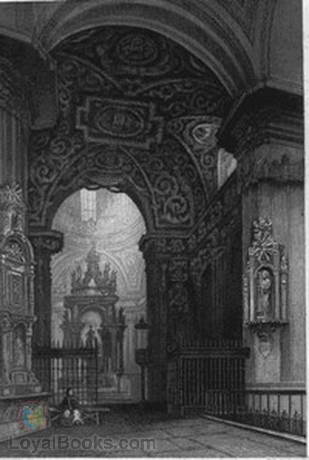|
Books Should Be Free Loyal Books Free Public Domain Audiobooks & eBook Downloads |
|
|
Books Should Be Free Loyal Books Free Public Domain Audiobooks & eBook Downloads |
|
The Picturesque Antiquities of Spain Described in a series of letters By: Nathaniel Armstrong Wells |
|---|

The Picturesque Antiquities of Spain Described in a series of letters by Nathaniel Armstrong Wells is an enthralling journey through the rich cultural heritage of Spain. Wells, an esteemed traveler and historian, takes us on a visually captivating exploration of the country's architectural marvels, historical significance, and vibrant landscapes.
Through a series of vividly descriptive letters, Wells paints a detailed picture of Spain's picturesque antiquities. His prose skillfully brings to life grand castles, graceful cathedrals, and charming towns that are steeped in history. It is apparent that Wells possesses a deep love and appreciation for the country, as his words effortlessly convey the splendor and allure of these architectural gems.
The book is structured as a collection of letters, adding a personal touch to the narrative. Wells writes with a genuine sense of wonder and curiosity, as if he were sharing his experiences with a close friend. This conversational tone allows readers to immerse themselves in his adventures, making the reading experience all the more enjoyable.
One of the most admirable qualities of Wells' writing is his attention to detail. He meticulously describes the ornate carvings, intricate mosaics, and elaborate frescoes adorning the ancient buildings. Readers will find themselves lost in his vivid descriptions, almost feeling as though they are exploring these antiquities firsthand.
Wells also delves into the historical significance of these architectural treasures, providing readers with valuable insights into the cultural tapestry of Spain. His extensive research is evident, as he effortlessly weaves historical context into his letters. This adds depth and substance to the book, elevating it beyond a mere travelogue and transforming it into a captivating history lesson.
Moreover, the inclusion of stunning photographs further enhances the visual experience of reading this book. The carefully selected images capture the essence of the picturesque antiquities, allowing readers to appreciate their sheer magnificence. These visuals complement Wells' articulate descriptions, providing readers with a more holistic understanding of the subject matter.
While The Picturesque Antiquities of Spain is undeniably a delight for history enthusiasts and travel lovers, it may not appeal to those seeking a fast-paced, action-packed narrative. The book requires a patient reader who appreciates the art of storytelling and possesses an interest in history and architecture.
In conclusion, Nathaniel Armstrong Wells' The Picturesque Antiquities of Spain Described in a series of letters is a captivating exploration of Spain's architectural wonders and historical treasures. Wells' impeccable prose, attention to detail, and passion for his subject matter make this book a valuable addition to any library. Whether you dream of traversing the cobbled streets of ancient towns or are simply eager to learn more about Spain's fascinating past, this book promises to transport you on an enchanting journey through time. [Illustration: CHAPEL OF SAN ISIDRO, IN THE CHURCH OF SAN ANDRES, MADRID.] THE PICTURESQUE ANTIQUITIES OF SPAIN; DESCRIBED IN A SERIES OF LETTERS, WITH ILLUSTRATIONS, REPRESENTING MOORISH PALACES, CATHEDRALS, AND OTHER MONUMENTS OF ART, CONTAINED IN THE CITIES OF BURGOS, VALLADOLID, TOLEDO, AND SEVILLE. BY NATHANIEL ARMSTRONG WELLS. LONDON: RICHARD BENTLEY, NEW BURLINGTON STREET, Publisher in Ordinary to Her Majesty. M.DCCC.XLVI. LONDON: Printed by S. & J. BENTLEY, WILSON, and FLEY, Bangor House, Shoe Lane. PREFACE. The author of the following letters is aware that his publication would have possessed greater utility, had the architectural descriptions been more minute. He ventures to hope, however, that this imperfection may be in some measure balanced by the more extended sphere opened to whatever information it may contain. The absence of many technical expressions, especially those which enter into a detailed description of almost all Gothic buildings, and the employment of which was forbidden by the occasion, may tend to facilitate the satisfaction of popular curiosity respecting Spanish art: the more so from the circumstance that the most intelligent in such subjects are scarcely sufficiently agreed on the application of technical terms, to allow of the compilation of a standard vocabulary... Continue reading book >>
|
| eBook Downloads | |
|---|---|
|
ePUB eBook • iBooks for iPhone and iPad • Nook • Sony Reader |
Kindle eBook • Mobi file format for Kindle |
|
Read eBook • Load eBook in browser |
Text File eBook • Computers • Windows • Mac |
| Review this book |
|---|